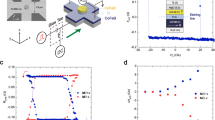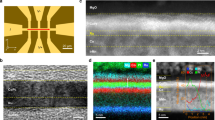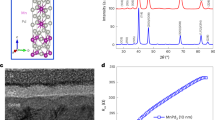Abstract
Manipulation of the magnetization of a perpendicular ferromagnetic free layer by spin–orbit torque (SOT)1,2,3,4 is an attractive alternative to spin-transfer torque (STT) in oscillators and switches such as magnetic random-access memory (MRAM) where a high current is passed across an ultrathin tunnel barrier5. A small symmetry-breaking bias field is usually needed for deterministic SOT switching but it is impractical to generate the field externally for spintronic applications. Here, we demonstrate robust zero-field SOT switching of a perpendicular CoFe free layer where the symmetry is broken by magnetic coupling to a second in-plane exchange-biased CoFe layer via a nonmagnetic Ru or Pt spacer6. The preferred magnetic state of the free layer is determined by the current polarity and the sign of the interlayer exchange coupling (IEC). Our strategy offers a potentially scalable solution to realize bias-field-free switching that can lead to a generation of SOT devices, combining a high storage density and endurance with a low power consumption.
This is a preview of subscription content, access via your institution
Access options
Subscribe to this journal
Receive 12 print issues and online access
$259.00 per year
only $21.58 per issue
Buy this article
- Purchase on Springer Link
- Instant access to full article PDF
Prices may be subject to local taxes which are calculated during checkout



Similar content being viewed by others
References
Miron, I. M. et al. Perpendicular switching of a single ferromagnetic layer induced by in-plane current injection. Nature 476, 189–193 (2011).
Liu, L., Lee, O. J., Gudmundsen, T. J., Ralph, D. C. & Buhrman, R. A. Current-induced switching of perpendicularly magnetized magnetic layers using spin torque from the spin Hall effect. Phys. Rev. Lett. 109, 096602 (2012).
Liu, L. et al. Spin–torque switching with the giant spin Hall effect of tantalum. Science 336, 555–558 (2012).
Fan, Y. et al. Magnetization switching through giant spin–orbit torque in a magnetically doped topological insulator heterostructure. Nature Mater. 13, 699–704 (2014).
Ikeda, S. et al. A perpendicular-anisotropy CoFeB–MgO magnetic tunnel junction. Nature Mater. 9, 721–724 (2010).
Parkin, S. S. P., More, N. & Roche, K. P. Oscillations in exchange coupling and magnetoresistance in metallic superlattice structures: Co/Ru, Co/Cr, and Fe/Cr. Phys. Rev. Lett. 64, 2304–2307 (1990).
Mangin, S. et al. Current-induced magnetization reversal in nanopillars with perpendicular anisotropy. Nature Mater. 5, 210–215 (2006).
Yu, G. et al. Switching of perpendicular magnetization by spin–orbit torques in the absence of external magnetic fields. Nature Nanotech. 9, 548–554 (2014).
Safeer, C. K. et al. Spin–orbit torque magnetization switching controlled by geometry. Nature Nanotech. 11, 143–146 (2015).
You, L. et al. Switching of perpendicularly polarized nanomagnets with spin orbit torque without an external magnetic field by engineering a tilted anisotropy. Proc. Natl Acad. Sci. USA 112, 10310–10315 (2015).
Fukami, S., Zhang, C., DuttaGupta, S., Kurenkov, A. & Ohno, H. Magnetization switching by spin–orbit torque in an antiferromagnet–ferromagnet bilayer system. Nature Mater. 15, 535–541 (2016).
Nogués, J. & Schuller, I. K. Exchange bias. J. Magn. Magn. Mater. 192, 203–232 (1999).
Parkin, S. S. P. Systematic variation of the strength and oscillation period of indirect magnetic exchange coupling through the 3d, 4d, and 5d transition metals. Phys. Rev. Lett. 67, 3598–3601 (1991).
Brataas, A., Nazarov, Y. V. & Bauer, G. E. W. Finite-element theory of transport in ferromagnet–normal metal systems. Phys. Rev. Lett. 84, 2481–2484 (2000).
Lee, O. J. et al. Central role of domain wall depinning for perpendicular magnetization switching driven by spin torque from the spin Hall effect. Phys. Rev. B 89, 024418 (2014).
Haazen, P. P. J. et al. Domain wall depinning governed by the spin Hall effect. Nature Mater. 12, 299–303 (2013).
Emori, S., Bauer, U., Ahn, S. M., Martinez, E. & Beach, G. S. Current-driven dynamics of chiral ferromagnetic domain walls. Nature Mater. 12, 611–616 (2013).
Khvalkovskiy, A. V. et al. Matching domain-wall configuration and spin-orbit torques for efficient domain-wall motion. Phys. Rev. B 87, 020402 (2013).
Torrejon, J. et al. Interface control of the magnetic chirality in CoFeB/MgO heterostructures with heavy-metal underlayers. Nature Commun. 5, 4655 (2014).
Thiyagarajah, N. et al. Giant spontaneous Hall effect in zero-moment Mn2RuxGa. Appl. Phys. Lett. 106, 122402 (2015).
Liu, Z. Y. et al. Oscillatory antiferromagnetic interlayer coupling in Co(4Å)/Pt(tPtÅ)/[Co(4Å)/Pt(6Å)/Co(4Å)]/NiO(20Å) multilayers with perpendicular anisotropy. Phys. Rev. B 77, 012409 (2008).
Chen, Y.-T. et al. Theory of spin Hall magnetoresistance. Phys. Rev. B 87, 144411 (2013).
Nakayama, H. et al. Spin Hall magnetoresistance induced by a nonequilibrium proximity effect. Phys. Rev. Lett. 110, 206601 (2013).
Althammer, M. et al. Quantitative study of the spin Hall magnetoresistance in ferromagnetic insulator/normal metal hybrids. Phys. Rev. B 87, 224401 (2013).
Avci, C. O. et al. Unidirectional spin Hall magnetoresistance in ferromagnet/normal metal bilayers. Nature Phys. 11, 570–575 (2015).
Kim, J., Sheng, P., Takahashi, S., Mitani, S. & Hayashi, M. Spin Hall magnetoresistance in metallic bilayers. Phys. Rev. Lett. 116, 097201 (2016).
Kim, J. et al. Layer thickness dependence of the current-induced effective field vector in Ta|CoFeB|MgO. Nature Mater. 12, 240–245 (2013).
Garello, K. et al. Symmetry and magnitude of spin–orbit torques in ferromagnetic heterostructures. Nature Nanotech. 8, 587–593 (2013).
Thiaville, A., Rohart, S., Jué, E., Cros, V. & Fert, A. Dynamics of Dzyaloshinskii domain walls in ultrathin magnetic films. Europhys. Lett. 100, 57002 (2012).
Ryu, K.-S., Thomas, L., Yang, S.-H. & Parkin, S. Chiral spin torque at magnetic domain walls. Nature Nanotech. 8, 527–533 (2013).
Néel, L. Sur un nouveau mode de couplage entre les aimantations de deux couches minces ferromagnétiques. C. R. Hebd. Acad. Sci. 255, 1676–1681 (1962).
Vinai, G. et al. IrMn microstructural effects on exchange bias variability in patterned arrays of IrMn/Co square dots. J. Phys. D 47, 195302 (2014).
Acknowledgements
This work was supported by Science Foundation Ireland through AMBER and by grant no. 13/ERC/I2561. KR acknowledges financial support from the European Community's Seventh Framework Programme IFOX, NMP3-LA-2010-246102. D.B. acknowledges financial support from IRCSET. The authors thank G.Q. Yu, N. Thiyagarajah and J.Y. Chen for fruitful discussions, Q. Chevigny for the assistance in lithography and K. Borisov for some of the magnetometry.
Author information
Authors and Affiliations
Contributions
Y.C.L. and D.B. contributed equally to this work. Y.C.L. and D.B. designed the experiment and planned the study with the input from K.R. D.B. grew the samples and fabricated the devices. Y.C.L. and D.B. measured the devices. D.B. performed data analysis. Y.C.L. and D.B. wrote the manuscript with advice from J.M.D.C. and P.S.
Corresponding author
Ethics declarations
Competing interests
The authors declare no competing financial interests.
Supplementary information
Supplementary information
Supplementary information (PDF 781 kb)
Rights and permissions
About this article
Cite this article
Lau, YC., Betto, D., Rode, K. et al. Spin–orbit torque switching without an external field using interlayer exchange coupling. Nature Nanotech 11, 758–762 (2016). https://doi.org/10.1038/nnano.2016.84
Received:
Accepted:
Published:
Issue Date:
DOI: https://doi.org/10.1038/nnano.2016.84
This article is cited by
-
Bifurcation to complex dynamics in largely modulated voltage-controlled parametric oscillator
Scientific Reports (2024)
-
The central role of tilted anisotropy for field-free spin–orbit torque switching of perpendicular magnetization
NPG Asia Materials (2024)
-
Spintronic leaky-integrate-fire spiking neurons with self-reset and winner-takes-all for neuromorphic computing
Nature Communications (2023)
-
Field-free spin-orbit torque switching assisted by in-plane unconventional spin torque in ultrathin [Pt/Co]N
Nature Communications (2023)
-
Field-free spin-orbit switching of perpendicular magnetization enabled by dislocation-induced in-plane symmetry breaking
Nature Communications (2023)



